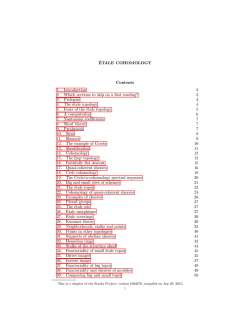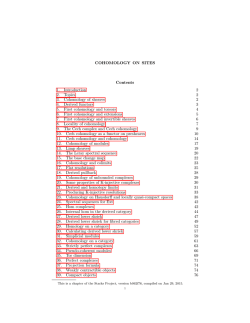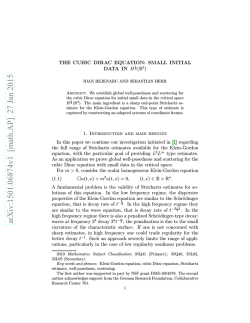
28723___.PDF - Radboud Repository
PDF hosted at the Radboud Repository of the Radboud University
Nijmegen
The following full text is a publisher's version.
For additional information about this publication click this link.
http://hdl.handle.net/2066/28723
Please be advised that this information was generated on 2015-02-06 and may be subject to
change.
T h e J o u r n a l o f S y m b o lic L o g ic
Volume 6 1, Number 3, Sept, 1996
SOME ELEMENTARY RESULTS IN INTUITIONISTIC MODEL THEORY
WIM VELDMAN AND FRANK WAALDIJK
Abstract. Wc establish constructive refinements of several well-known theorems in elementary model
theory. The additive group of the real numbers may be embedded elementarily into the additive group of
pairs of real numbers, constructively as well as classically.
Introduction. Intuitionistic model theory, as we understand it, is part of intuitionistic mathematics. We study intuitionistic structures from the model-theoretic
point o f view in an intuitionistic way. We are not trying to find non-intuitionistic
interpretations of formally intuitionistic theories.
The paper is divided into eight sections. In Section 1 we notice that notions such
as “elementary equivalence” and “elementary substructure” have a straightforward
constructive meaning. We classify formulas according to their quantifier-depth
and define corresponding refinements of the basic model-theoretic concepts. We
introduce strongly homogeneous structures, that is, structures with the property that
every local isomorphism extends to an automorphism of the structure. We also
introduce the weaker notion of a back-and-forth-homogeneous structure. We prove
a theorem that will help us to find elementary substructures of back-and-forthhomogeneous structures.
In Section 2 we recapitulate the intuitionistic construction of the continuum and
prove that the structure (R, <) is strongly homogeneous.
In Section 3, we consider subsets A of M such that (A } <) is an elementary
substructure of (R, <). We recover and extend the most important results of [7]. In
Section 4, we prove that intuitionistic Baire space (^ ,# o ) (the universal spread),
considered as a set with an apartness relation, not with an order relation, is strongly
homogeneous, and we mention some applications of this result. Section 5 is our
first intuitionistic intermezzo. We discuss some consequences of the continuity
principle, and show that the apartness structure (R, #) is not strongly homogeneous,
In Section 6 we prove that (R ,#) is back-and-forth-homogeneous. In Section
7, our second intuitionistic intermezzo, we show that Fraisse’s characterization of
elementary equivalence is not valid constructively. In Section 8 we study (R, +),
the additive group of the real numbers, and consider several structures that are
elementarily equivalent to (R, +).
Most of our proofs, although intuitionistically correct, may count as “classical”
proofs of the corresponding “classical” theorems. Nobody will find fault with our
avoidance of indirect arguments. In the proof of Theorem 3.3.4 we use a version
of the axiom of countable choice. This version of the axiom of countable choice is
Received March 15, 1994; revised November 21, 1994, and July 5,1995.
©
745
1996, Association for Symbolic Logic
0022-4812/96/6103-0002/S3.30
WIM VELDMAN AND FRANK WAALDIJK
746
accepted in intuitionistic mathematics, and, as one may see for instance at page 15
of [5], it is also accepted in the wider circle of constructive mathematics. Specifically
intuitionistic axioms are used in Sections 5, 7 and 8.3, but nowhere else.
To a large extent our constructive treatment of model-theoretic questions was
inspired by the work of R. Fraisse who, although reasoning classically, sought for
direct arguments in model theory.
“Iff” means “if and only if55.
We hereby express our thanks to the referee, whose comments led to some im
provements of the paper, especially in Section 1.
§1. On intuitionistic model theory.
1.0. In this paper we study mathematical structures 21 = (^,7?,£/o,rt|,... ,(tm~ i)
where A is a set, R is a relation on A, either a 1-ary relation, or a 2-ary relation or a
3 -ary relation, and (ao> a i , . . . ,
is a finite sequence of elements of A , so-called
constant elements of A . The signature (or similarity type) of such a structure will
be given by a pair of natural numbers (/, m) where i denotes the arity of the relation
and m the length of the sequence of constant elements. Structures 21,03 with the
same signature will be called similar structures.
If 21 = (A ,R ,ao,ai,... ,
i) is a structure and bo,b\>... ,
i is a finite se
quence of elements of 21, we will denote the structure (A, R , ao> 0 1>• • * *
l >ho» h \»
... , bfl—\) by (21, b\, . , .
i),
To each pair (z, m) corresponds a first-order-language L(/tW
1). The mathematical
symbols of L ^ m) are an i-ary relation symbol P and m distinct individual constan ts:
Cfc Cl,... , Cm•—1•
The formulas of the language £(,•„,) are built up in the usual way, from the
mathematical symbols, the logical symbols and several auxiliary symbols such as
brackets and parentheses. Among the logical symbols of the language are the
connectives A
and -i and the quantifiers V, 3. Intuitionistically, it is impossible
to define any of them in terms of the others. The languages
do not contain an
equality symbol.
*o. x i,x 2,... is the list of individual variables of the language L((>). Free and
bound occurrences of a variable x t in a formula <p are defined as usual. “A formula
= <f>(x(nxi,... , x„_i)” means “a formula <f>such that every individual variable
that occurs freely in <t>is one of the variables xo, x \ , ... , x„_|,”
1.1. Let 21 = (A,R,ao,a\ , ... , a„,_i) be a mathematical structure. We define,
for every formula (j>= <j>{xo,x\ , ... ,x„_i) from the appropriate first-order-language
and every finite sequence
j of elements of A, the statement:
51 h <l>[bo,b\,... A - | ]
( > is true in the structure 21 if we interpret
xo by ba,x\ by bu ...
by b„-i")
just as Tarski did, with the important proviso that connectives and quantifiers are
interpreted constructively. Observe that, for every formula <j>= d>(xn, xt
x i)
an every finite sequence ¿o, ¿ 1, • • •, 6 n- i of elements of A:
% 1=
¿1 , . . .
, 6 „_ 1] iff (Ql, b0, by........b„_,) 1= 4 '
SOME ELEMENTARY RESULTS IN INTUITIONISTIC MODEL THEORY
747
where <j>f is the sentence from the language L(/|rt+w) that we get from by replacing,
for every i < n, every free occurrence of the individual variable Xf by the individual
constant cw+/.
The following lemma is easy.
L emma 1.2. Let 21 = (A , . . . ) and 03 = [B, . . . ) be similar structures,
Le/ (j) ~ 4>{x) be a formula from their common first-order-langu age. Suppose: for
every a in A there exists b in B such that: 21 f= </>[a] iff 03 ¡= 0[6].
Then:
(i)
I f 211= 3x[0(x)], then 03 |= 3x[0(x)]
and
(ii)
I f 03 |= Vx[0(jc)],
2t |= Vx[<p(x)].
P roof . The proof is a straightforward application of the truth definition.
H
1.3. Let £ be one of our first-order-languages, To any formula 0 from £
we associate a natural number, QD(<f>), the quantifier-depth of <f>. If ^ has no
quantifiers, then QD{</>) = 0. Further, QD(Vy[(/>]) = QD(3y[</)]) = QD(<f>) -I-1
and QD{(j> A iy ) = QD{(j> V yz) =
= M ax(gD (0), ¿ D (^ )). Finally,
Q D (-></)) — QD(<j))t
1.4. We define some model-theoretic notions. Let 21 = (.4, i?, ao, a i , . . , , aw,_i)
and 03 = (By £ ,£ 0 , 61 , . . . >¿w-i) be similar structures. For each natural number n}
21 is n-elementarily equivalent to 03 (notation: 21 =n 58) iff for every sentence (j) from
their common first-order-language: if QD(<f>) < n, then 21 j=s <j>iff 03 |= <f>.
21 is elementarily equivalent to 03 (notation: 21 = 58) iff for each n : 2t =„ 03.
For each natural number n, 21 is an n-elementary substructure of 03 (notation:
21 -<w 03) iff A C B and for each finite sequence (c0, c\9♦.. , cp„ 1) of elements of
2 1 . (2 t,Co,cj,... > —1)
(03jcq,Ci,... ,c^j_«i).
21 is a substructure of 03 iff 2t is a 0-elementary substructure of 03,
21 is an elementary substructure of 2$ (notation: 21 -< 93) iff for each n: 21 -<n 03.
L emma 1.5 (Fraisse’s Lemma), Let 21 = (^4,...) and 03 = [B ,. . . ) be similar
structures, Then, /or each natural number n:
I f V a e A3b E B [{% a) = M(03,6)] and VA € 5 3 a e >4[(2l,a) s„ (23,6)1 then
21 = ,1+i 03.
P roof , The lemma follows easily from Lemma 1.2.
H
In our second Intuitionistic Intermezzo, Section 7, we show that the converse of
Lemma 1.5, classically part of a famous result of Fraisse’s, (see [1]), fails construc
tively.
1 .6 .
In this subsection, we introduce strongly homogeneous and back-and-forthhomogeneous structures. We start with some preliminary definitions.
1.6.1.
Let 21 = (A 3R, an, a\>,,. , a,„_i) be a structure. Without loss of general
ity we assume that ii is a binary relation on A. We define an equivalence relation
~ 51 on the set A> as follows: for all a, b G A : a
b iff for every c in A: cRa iff
cR b, and aR c iff bRc.
is the finest equivalence relation on the set A that respects the relation R.
748
WIM VELDMAN AND FRANK WAALDIJK
Given any subset ƒ of A x B we define ƒ to be the closure of ƒ under the
equivalence relations
and
, that is, ƒ consists of all pairs (c, d) in A x B such
that there exists c d f in A, B respectively with the property: c ^ c.' and d
df
and {ctJd /) belongs to ƒ .
1.6.2. Let 21 — {A, R>ciq, a\ , ... ,
and 93 — {B, S, 6 o>6 i>...
be
similar structures. We assume, without loss of generality, that R ,S are binary
relations on A> B respectively. A subset ƒ of A x B is called a local isomorphism
from 21 to 93 iff for all pairs (co>^o)> (c\»d\) in ƒ : cqR c\ iff doSd\ and for all
i < m : (fl/, 6 /) belongs to ƒ .
We use this definition of "local isomorphism from 2t to 93” as equality is not men
tioned in the language of our structures. There are many situations in constructive
mathematics where equality is a defined notion and not a primitive one.
For this reason, our notion of a local isomorphism from 21 to itself slightly differs
from Fraisse’s notion, see [1].
A local isomorphism ƒ from 21 to 95 is called a homomorphism from 21 to 93 iff
for each c in A there exists d in B such that (c, d) belongs to ƒ . A homomorphism
is called an isomorphism from 2Uo 95, if, in addition, for each d in B there exists c
in A such that (c, d ) belongs to ƒ .
Observe that, if A C B, then 21 is a substructure of 93 iff the identity mapping
from A to B , seen as a set of ordered pairs, is a homomorphism from 21 to 93.
Observe that, if ƒ is a homomorphism from 21 to 95, then for all (co, do), (ci, d \)
in ƒ: If 4 ^*8 d\, then cq
c\ .
Observe that, if ƒ is an isomorphism from 21 to 93 then for all (cq, g?o)> (ci >d \) in
ƒ: If Co ^21 c\i then do
d \t
An isomorphism from 21 to itself is called an automorphism of 21.
1.6.3. Let 21 = [Ay. , . ) be a structure. We say that 21 is strongly homogeneous iff
for all finite sequences (co3ci>..« >Cp-i) and
,d p- \ ) of elements of 21 of
equal length: If (2l,co,ci3...
}^~ i ) , t h e n there exists an
automorphism ƒ of 21 such that for all i < p : (ci3 df) belongs to ƒ .
Observe that, if (21, c$3c \ .. 7cp„ i ) = o (2l,do3^b--- ,^_i),thentheset{(co,i/o)j
(c\i d \ ) , ... ,{cp- \ , d p- \ ) } is a local isomorphism from 21 to itself.
1.6.4. Let 21 = ( A , . . . ) be a structure. We say that 21 is back-and-forthhomogeneous iff for all finite sequences (co, c \9... , cp- \ ) and (do, d \ , ... , dp- 1) of
elements of A of equal length: If (2l,co,ci,... >cp - 1) =o (%l,do3d u . .. ,d p^ i),
then for every c in ^4 there exists d in A such that (2taco,ci,... iCp- \ ,c ) =o
(21,d0j d\,.»» , dp—\$d^,
Observe that it follows from Lemma 1.5 that, for each structure 21, if 21 is
back-and-forth-homogeneous, then for all finite sequences (cq>ci3... ,cp- i) and
{do,d\3... >dp_\) of elements of A of equal length, if (2t,co,ci,... ,cp- \) =o
(21, Jq, d\ , ... >dp~ i) then (2 l,CQ3 Cb...
(QL3d^,d\ , ... >dp- \) (and also,
for each n in N, (21, co, c\> • • • >cP~i)
do>di, ... , dp-\)).
Observe that each strongly homogeneous structure (see Definition 1.6.3) is backand-forth-homogeneous.
T heorem 1.6.5. Let 21 = ( ^ , . . . ) be a back-andforth-homogeneous structure
and let 53 = (B}. . . ) be a substructure o f 21 such that for every finite sequence
SOME ELEMENTARY RESULTS IN INTUITIONISTIC MODEL THEORY
749
(60 , b\, . . . , 6 ^ 1) 0/ elements o f B and every element a o f A there exists an element
b o fB such that (21,6 o, b\s... , bp- \ , a ) =o (21? 60 , 61 , . . . , 6 ^ - 1, 6 ). Then: 25 -< 2t.
P ro o f . One proves by induction that for each natural number n, for every finite se
quence
• • • >bp- 1) of elements of B\ (23 , 6036 b • • ■>bp~\) =„ (21,60 , 61 , *• • >
bP-\)The induction step uses Lemma 1.5 and the remark in Section 1,6.4,
H
§2. The structure (R, <) as an example of a strongly homogeneous structure.
2.0. We define a real number as a pair a = (a 1, a") of functions from the set N
of natural numbers to the set Q of rational numbers such that
Vft € N[a;(«) < a!(n + 1 ) < a!*{n + 1) < a /7(n)]
and
V# G QVr € Q[q < r
3n G N[# < a 'i« ) V a n(n) < r]],
(The latter condition is equivalent to: Vm G N3 h G N[a"(w) - a'(n) < ¿-].)
The set of all real numbers will be denoted by R.
Intuitionistically, this ‘set5 is introduced as a subspecies of the spread of all
functions from N to Q x Q. We will not go into details, but the reader may
consult [2] or [6 ] or [4].
2.1. We define a binary relation < on R, as follows:
for all
inR : a < p iff 3/i G N[a"(«) < ƒ?'(«)].
As is well-known, this relation < is co-transitive, that is, for all a }ft, y in M: if a < P
then either a < y or y < ƒ?. We define a function / from Q to R by: for each q in
Q : i(q) = {qf, qn) where, for each n in N, q*{n) — q/f{n) — q .
Observe that this function i is a homomorphism from (Q, <) to (R, <) and also,
for instance, from (Q, <, 0) to (R, <, i (0)). Observe that for all a, p in R: if a < p
then 3q G Q[a < i (q) and i (q) < /?], that is, Q is embedded densely into R.
L emma 2.2. Let f be an automorphism o f the structure (Q, <), that is, an order-
preserving mapping from the set o f rationals onto itself
There exists an automorphism f * o f the structure (R, <) such that for every q in
Q • ƒ*(*(?)) =
that is, f * 0 i = i o ƒ .
P roof . Let ƒ be the given automorphism of the structure (Q, <). We define
its extension ƒ* to R as follows: for each real number a = (a', a") : f * { a ) :=
(ƒ o a f3f o a"). One verifies easily that ƒ * has the required properties.
H
2.3.
We define binary relations
# and = on R, as follows: for all a, /? in R:
a ^ p iff-.(£ < a), that is Vh G N[a'(n) S P"{n)]
a # p (“a lies apart from /?”) iff a < P or /? < a
a = p (“a coincides with /?, a is equal to /?”) iff -»(a#/?), that is, a ^ p and
P ~
Observe that = is the equivalence relation belonging to the structure (R, <) in the
sense of Section 1.6.1: for all a s p in R:
a = p iff for every y in R: y < a iff y < /? and a < y iff p < y .
750
WIM VELDMAN AND FRANK WAALDIJK
Observe also that the relation # is co-transitive.
for all a, P, y in R: if a#/?, then either a # y or y#p.
We formulate an extension of Lemma 2.2.
L emma 2.4. Let f be a local isomorphism from the structure (Q, < ) to itself such
that both the domain o f f , Dom( ƒ), and the range o f ƒ , Ran( ƒ ) are dense in Q.
There exists an automorphism ƒ * o f the structure (IK, <) such that 'iq G Dom( ƒ )
[ƒ*(%)) = /(ƒ(<?))]•
, n
jr
(A subset A o f Q is called dense in Q iff\/q,r € Q [If q < r, then 3a € A[q < a <
- r}]-)
P roof. The proof is similar to the proof of Lemma 2.2. Observe that, for every
subset A of Q that is dense in Q, every real number coincides with a real number
P = (ƒ?', p") such that both p' and /?" are functions from N to A.
H
Lemma 2.5. Let (a0, a \ , ... , a m_i) be a finite sequence o f real numbers. Define a
subset A o f Q as follows: A := {q 6 Q | Vy < m[i(q) < atj V atj < /(i/)]}. Then:
(i) There exists a function y : N —>Q such that A = {y{n) | n £ N}, that is: A
is an enumerable subset o f Q.
(ii) Every finite sequence (bo,b],... ,bm) o f m + 1 different rational numbers
contains at least one member o f A.
(iii) A is dense in Q.
P roof.
(i) Let qo, q\, ■■■be an enumeration of the set <Q>of rational numbers. Let p be
an element of A .
For each n in N, let no and n\ be the natural numbers such that n = 2"° (2« i + 1) - 1 .
We define the function y as follows. For each n in N if Vy < m[q,t() < a '^ n i) V
aj (”i) < 9n0]. then y(«) := qm>if not, then y{n) := p.
It is easy to see that y enumerates A .
(ii) One may prove by induction that for each natural number m > 0, if
(Poifiif- ,fim) and (ao,au,... , a„,_i) are finite sequences of real numbers of
length m + 1 and m, respectively, and fAi<j<mih#Pj, then V,<„, Ay<„, A/#«/.
If m = 1, use the co-transitivity of the apartness relation. In the induction step,
use a simple combinatorial argument.
(iii) Follows from (ii).
_l
T heorem 2,6 (The structure (E, < ) is strongly homogeneous). Let (a„, a , , . . . ,
am_j) and (/?o,/?i, • • •
be finite sequences o f real numbers such that (1R,
<’
■>am - 1) =o (R,< , Pq, P \ , . .. , P,n—\) that is: V/ < mV/c < m[a; < atWPj < h i
There exists an automorphism f o f the structure (R, <) such th a t'ij < m [ f (a,) =
fijl
Proof. Consider^ := {q e Q | Vj < m[i{q) < Qj v a, < i(q)} and B := {q e
Q | V; < m[i(q) < fij V fij < i{q)}.
'
;
U
If/; belongs to A and r belongs to B we say that p is similar to r iffV/ < mli(n) <
a j iff i{r) < fa],
'
lwy
SOME ELEMENTARY RESULTS IN 1NTUITIONISTIC MODEL THEORY
751
Observe that, given any p in A, there exists at least one r in B that is similar to
p> and therefore infinitely many, as Vy < raV/c < m[aj < a * iff ßj < ß/{]. Likewise,
given any r in B, there exist infinitely many p in A that are similar to r.
We also know, from Lemma 2.5, that both A and B are enumerable subsets of Q. It
is possible, therefore, to establish, by a Cantor back-and~forth~argument, a mapping
g from A onto B that is order-preserving and such that for every p m A }p is similar
to g(p). According to Lemma 2,4 g extends to an automorphism ƒ of the structure
(R, < ). It is easy to see that V/ < m [ f (a/) = ßj] as Vy < m\/q £ A[i{q) < a/ iff
i{g{q))<ßjl
h
§3. Some elementary substructures of (R, < ).
3.0. In this section we consider classes of subsets A of R with the property
{ A , < ) ~< (R ,< ).
3.1. We call a subset A of R an open subset of R iff Va <GA 3ß £ R3y £ R[/? <
a < y A V5 £ R[/? < ö < y —>ö £ A]]. Observe that, for each open subset A of R,
for each a in A , for each ( in R, either a # f or ( £ A. (Determine /?, y in R such
that ß < a < y and VS £ R[ß < S < y —» S £ A], Then: ß < ( V f < a and
a < £ V f < y . Therefore, either: f < a or a < f or: ß < f < y, that is: either a#£
or C £ A )
Similarly, for each open subset A of R?for each finite sequence ao, aq,... , a m~\
of elements of A , for each £ in R, either Vy < m [ a j # Q or ( £ A.
We call a subset A of R inhabited iff 3a £ R[a £ A \, that is, iff we are able to
indicate at least one element of A.
T heorem 3.1.1, Let A be an open and inhabited subset o f R Then (A, <) -< (R,
<).
P r o o f . According to Theorems 1.6.5 and 2.6 it suffices to show: for each finite
sequence (ao, a i , ... , a,„_i) of elements of A, each ß in R, there exists a in A such
that
(R,
j ao, a j , . . , j a;;;—| , a) ™o (R, ^ , ao, a i , . . . , a/^—i, ß ').
Let (ao, ol\ , . . . , a,„ ^ \) be a finite sequence of elements of A , and let ß be an element
of R.
As we saw in Section 3.1 we may distinguish two cases:
Case (1). Vy < w[a/#/?]. It is possible to find a in A such that Vy < m[(aj <
a ^ aj < ß) A (a < aj ^ ß < a/)].
Case (2). ß belongs to A. We may define a := ß.
If m = 0, we need the assumption that A is inhabited.
H
3.1.2.
For each a, ß in R we define: (a, ß) := {y £ R | a < y < ß } } that is:
(a, ß) is the open interval determined by a 3ß . It follows from Theorem 3,1,1 that
both the set (0,2) and the set (0,1) U (1,2) give rise to an elementary substructure of
(R, <). Therefore also ((0,1) U (1,2), <) -< ((0,2), <). This re-establishes a result
contained in [8 ] but actually proved for the first time by Tonny Hurkens.
Theorem 3.1.1 seems to be a proper generalization of this result. It implies also,
for instance, that the set (0,2) U {x £ R | 1 < x < 3 and “Riemann’s hypothesis”}
gives rise to an elementary substructure of (R, <).
752
WIM VELDMAN AND FRANK WAALDIJK
The proof that we gave of Theorem 3.1.1 is essentially the same as the proof of
its special case given in [8 ],
3.2. We call a subset A of R dense in E iff Va E RV/? E R[a < fi
3y € A[a <
7 < P]l
T h eo rem
3.2.1. Let A 0, A i , ... be a sequence o f dense and open subsets o f R.
Then:
( f ] A „ , < ) -< (R, <)
neN
P roof. According to Theorems 1.6.5 and 2.6 it suffices to show:
For each finite sequence ( a o »atm-i) of elements of
eac^ P
in R, there exists a in P|«eN^ suc^
(^ J<>a o>a i>• • • >a m- 1j ° 0 =o (R 3 <>
^•0 >aj,. . . j OtfYi—i */?)•
Let (aojCKi,...
be a finite sequence of elements of
anc* let P be
an element of R,
As we saw in the remarks preceding Theorem 3.1.1, we may decide, for each
natural number n, either V/ <
or ƒ? 6 A n.
Using an axiom of countable choice we determine a function y from N to {0,1}
such that \/n[y(n) < y{n -f 1)] and Vn[(y(/i) = 0 —>f} 6 A n) A (y{n) = 1 —> V/ <
Let {qo, ro), [q\, n ) , ... be an enumeration of all pairs (q, r) of rational numbers
such that q < r.
We now define a real number a = (a/* a"), step-by-step, first defining a' (0), a"(0),
then a'(l), a"(l), and so on. We take care that, for each natural number n:
(i) Ci'(n) < a f(n + 1) < a f,(n + 1 ) < a f,{n).
(ii) Either qn < a l(n) or a N(n) < rn.
(iii) </(oi,(«))>l(Qi//(w))> C A n.
(iv) If y(n) = 0, then there exists p in N such that a*(n) = /?'(ƒ>) and a /f{n) =
P”(p)‘
(v) If y(n) = 1 and V/ < n[y(i) = 0], then for each j < m , /(a'(rc)) < a/ iff
z(a"(«)) < aj iff/?< ay and a;- < i ( a f{n)) iff a; < ¿(»"(w)) iff
< /?.
We leave it to the reader to verify that it is possible to construct a! , a" in such a
way that these conditions are satisfied and that, if we do so, a is a real number that
belongs to f]nen A„ and (R, <, a0, a b . . . , a m_ h a) ==0 (R, <, a 0, . . . ,
C orollary 3.2.2. Let a 0, a i , . .. be a sequence o f real numbers and let A be a
subset of R such that Va E R[V/i 6 N[a#a„] -> a 6 A \
Then: (A , <) -< (R, <).
P roof. Define, for each n E N, A n
3.2.1.
{a E R | a # a „ } and apply Theorem
_l
3.2.3.
Corollary 3.2.2 implies that the set {a E R j ^fq E Q[z (<7)$*a]}- gives rise
to an elementary substructure of (1 , <), a result proved in [7 ].
Theorem 3.2.1 seems to be a proper generalization of this result.
There is another application of Corollary 3.2.2.
SOME ELEMENTARY RESULTS IN INTU1TIONISTIC MODEL THEORY
753
Consider the open interval I — (—1,1) and its subintervals
7o = H < 2 >
t
__
/
n
=
H ±X \
±n “ W l » «+2/J
T
__
/
»+1
— \ n+2»
n
\
h+1 / ’ ‘ ‘ '
This division of the interval (—1,1) into subintervals translates naturally into a
similar subdivision of any given interval A = (a , /?) (such that a: < ƒ?) into intervals
A qj A \ }A —\ , . , . and so on.
We now associate to any non-empty finite sequence a — {ciQ,a\ , , ., ,a m„ i) of
integers an open interval A a in R, as follows:
^(o)
i) * ( 2, l)j-^(2)
(2j 3),... , and for
each non-empty finite sequence a = {ay, ... , am... j) of integers for each integer
n :
0,
:==
,«,„-.))«• This system of open intervals generates a
mapping j of the set ZN of all infinite sequences of integers into R: for each
sequence a of integers j ( a ) is a real number that, for each natural number m > 0 ,
belongs to ^(«(O^aO),.,, ,a(w—!))•
The range of this function j coincides with the set of all real numbers that lie
apart from every endpoint of any interval A U) and thus, according to Corollary
3.2.2, gives rise to an elementary substructure of (R, <).
We define a binary relation <* on the set Z^; for all a, /? in ZN : a <* /? if and
only if 3n[a(n) < p{n) AV/ < n[a(j) ^ $(])]].
One now sees that j is an elementary embedding of the structure (ZN, <*) into
the structure (R, < ). Therefore, (ZN,<*) and (R, <) are elementarily equivalent
structures.
This answers a question left open in [8 ].
3.2.4.
The lexicographical ordering <* may be defined on the set
of all
sequences of rationals as well as on ZN: for all a,/? in
: a <* fl if and only
if 3n[a(n) < fi(n) A V/ < n[a(j) = ƒ?(./)]]• The structure (QN,<*) also embeds
elementarily into the structure (R, <).
We see this as follows. It suffices to embed (QN, <*) into (( -1, 1), <). We leave it
to the reader to associate to each rational number q an open interval Jq = ( j qf i j " )
in (—1 , 1 ) in such a way that (i) for each q, r in Q: if q < r } then j tfj < j[ and (ii)
the set U {Jq \ $ £ Q} is dense in (—1 , 1 ) and (iii) for each q in <Q), the length of
J[{i that is, j'/{ — j if}) is less than 1. We may construct, to any given open interval
B —
a similar system [Bq)qeq of subintervals of B , such that for each q in
Q, the length of Bq is less than ^(f}n - /?'),
We now associate to any non-empty finite sequence b —
,bm- i) of
rationals an open interval Bj} in (—1,1) as follows:
for each rational number q : B ^
Jq, and for each non-empty finite sequence
b = (b0,b\>...
of rationals, for each rational number q : B {boM....hm^ u({) :=
This system of open intervals generates in the obvious way a mapping k from the
set QN to the set R that satisfies, for all a , /? in QN: if a <* /?, then k{a) < k(fl).
Observe that the range of this mapping coincides with D;«eN UgQ»«
an<3
thus with a countable intersection of dense and open subsets of (-1, 1). Accord
ing to Theorem 3.2.1, the range of k gives rise to an elementary substructure
of ((—1 , 1 ), < ), and therefore, k is an elementary embedding from (QN, <*) into
754
WIM VELDMAN AND FRANK WAALDIJK
((-1,1), <) and also into (IK, <). So (Q, <*) and (E, <) are elementarily equivalent
structures and (QN, <*) and (ZN, <*) are elementarily equivalent structures. The
latter fact was stated without proof in [8 ].
One may verify that the structures (ZN, <*) and (QN, <*) are both strongly
homogeneous and that (Z^, <*) is an elementary substructure of (QN, <*).
3 .3 . We will reprove and generalize some results from [7]. We introduce a third
kind of elementary substructures of (R, <).
3.3.0. Let A be a subset of R. We call a real number a a left accumulation point
of A iff Vy E R[y < a
3(5 € A[y < 3 < a]], we call a a right accumulation point of
A iff Vy £ R[a < y
35 £ A[a < 3 < y]], and we call a a two-sided accumulation
point of A if a is both a left and a right accumulation point of A. We say that A is
a « o h e re n t subset of R iff every element of A is a two-sided accumulation point
of A. (Constructively, this is somewhat stronger than saying that A has no (left- or
right-) isolated points.)
3.3.1. It is not true constructively that every <-coherent subset of R gives rise
to an elementary substructure of (R, <). We mention two counterexamples. A
first counter-example is the set {i(q) | q £ Q}. The formula \/x iy [x P y V ~i(xPy)]
holds in the structure (Q, <), but by a weak version of the intuitionistic continuity
principle, its negation is true in (R, <), as we will see in Section 5. Let us define,
for each a, ß in R, [a, ß) := {y € R | a ^ y < ƒ?}, that is the left-closed-right-open
interval in R determined by a, ß. A second counterexample is the set (-1, 0) U[0,1).
The formula 3xVy[-^{yPx)VyPx] holds in the structure ( ( - 1 , 0)U[0,1), <) whereas,
again by a weak version of the intuitionistic continuity principle, its negation holds
in the structure (R, <). (These facts are shown in [8 ].)
3.3.2. We call a subset A of R a stable subset of R iff Va e R[~i->(a £ A)
a £ A].
We call a subset A of R a real subset of R iff Va £ RV/? € R[(a e A A a = ß)
ß £ A].
Observe that every open subset of R and also every subset of R that is a countable
intersection of open subsets of R is a real subset of R.
We will show that every inhabited, real, stable and <-coherent subset of R gives
rise to an elementary substructure of (R, <).
We need the following lemma.
4
3.3.3. Let A be a <-coherent subset o f R.
For everyfinite sequence (ao, a j , ... , a m_i) o f elements o f A, for every ß in R;
(i) I f \ / j < m[aj < ß l then 3y £ Ä i j < m[aj < y < ß]
(ü) I f V; < m[ß < dj], then 3y £ Ä i j < m[ß < y < ay].
Lem m a
P roof. We will prove (i), leaving (ii) to the reader.
Suppose Vj < m[ay < ß]. Determine Sq,S\} ...
in A such that V/ <
m[ay < 3j < ß l Define yo>y\,... , ym~ \ in A inductively, as follows: Let y0
<50.
Observe: ao < yo < ß and a\ < S\ < ß and distinguish two cases: case ( 1 ):
a i < yo> then take yi := yo and observe: ao < y\ and a\ < y\ or case (2 ): yo < 3\,
then take yi := 3\ and observe: ao < y\ and a\ < y it
Continue in this way. Choose one of the statements “a 2 < yi 53 or “yi < <52iS and
prove it. If you chose the first one, let y2 := yu if not, let y2 := S2. And so on.
After m steps we find y := ym~\ such that V/ < m\otj < y < ß] and: y £ A.
SOME ELEMENTARY RESULTS IN INTUITIONISTIC MODEL THEORY
755
(Observe that we have some freedom when carrying out the above instructions, as,
in general, case ( 1 ) does not exclude case (2 ).One may however obey the following
rule (we consider the definition of y\): wait for the first natural number n such that
either a!{ (n) < y ^ n ) or yd{n) < y{{n), say no, and follow case ( 1) if a{'(«0) < yo(«o)
and case (2 ) if not a{'(«o) < yo(«o))H
T h e o re m 3.3.4. Let A be an inhabited real, stable and <-coherent subset o f R,
Then (A, <) -< (R, <).
P roof . According to Theorems 1.6.5 and 2.6 it suffices to show that for each
finite sequence (ao, a \, . . . , otm- \ ) of elements of A, each ß in R, there exists a in A
such that (R, < , a o , a i , ... , a w_.i,a) =o
• • • >&m-\>ß)>
Let (ao, a i , ... , a m„ i) be a finite sequence of elements of A, and let ß be a real
number.
We now define a real number a = (a', a"), step-by-step, first defimnga'(O), a"( 0 ),
then a 'Q ^ a '^ l), and so on.
Step 0. We distinguish two cases.
Case (1): 3y < m [a}(0) < ^"(0) A ß'{0) < a'j(0)].
We define
a'(0) = Min({/?'(0)} U {a'j(0) | j < m | a j(0) < ß"(0) A ß ’(0) < a"(0)})
and
a ;/(0) = Max({/?"(0)} U {a'/(0) \ j < m \ aj(0) < ß n{0) A ß'{0) < aj'(0)}).
Case (2): Vy < 7w[/?"(0 ) < a'-(0) V a " (0) < ß f{0)]> and therefore: Vy < m[ß <
ctj V ay < ß ]. Using Lemma 3.3.3 we determine y in A such that Vy* < m[(ß <
ay —> y < ay) A (ay < ß —> ay < y)]. We define, for each natural number n:
a l(n) := y'(n) and a n(n) = ylf(n).
Step 1. We take this step only if we did not have Case (2) in Step 0, Again, we
distinguish two cases.
Case (1): 3j < w[a) (l ) < ß"{\) f\ ß l{\) < a"(l)].
We define
a ' ( l ) = M m ({ /?'(1 )} U
\ j < m \ a ' - ( l ) < /? "(!) A /?'(!) < a'j{ 1)})
and
a " { \ ) = M ax({£"(l)} U (a " (l) \ j < m \ a'j (1) < ß" ( l ) A ß '{\) < a" (l)}).
Case (2): V/ < m[ß"{\) < a' (l) V a' j(1) <
and therefore: Vj < m [ß <
ay V OLj < ß].
Determine y*o < m such that a'(0) < a'/o(0) < a jf Q(0) < a"(0). Without loss
of generality, we may assume: ay0 < /?. Using Lemma 3.3.3 we determine y in A
such that: y < ß and Vy < m[(ß < ay
y < ay) A (ay < ß
ay < y)] and:
<^(0 ) < y'(0 ) < y"(0 ) < a ;/(0 ).
We define, for each natural number n, a'(n + 1) := y'(w + 1) and a N{n + 1) :=
y"(» + l).
And so on.
756
WIM VELDMAN AND FRANK WAALDIJK
We leave it to the reader to verify that a is indeed a real number. We show
that a belongs to A. Remark that, if Vy < m[atj < ß V ß < <*/], then a € A.
If, on the other hand, - t i j < m[a/ < ß V ß < a ß , then ß = a and -i-. 3 j <
m[ß = a.j], (As this step requires some familiarity with constructive reasoning,
we spell it out. Suppose ->3j < m[ß = ay]. Then Vy < m[-i(ß == a;)], that is,
Vy* < m->-dn[a'j{n) < ß(n) V ß"(n) < a'-(w)]. This is equivalent to
<
m3n[aj (n) < ß(n) V ß"(n) < a'.(«)], (double negations commute with finite
conjunctions), that is — *Vy < m[ay < ß V ß < ay]. Contradiction. Therefore:
-t-eiy < rw[j8 = ay].)
Therefore, if--Vy'< m[ay < ß \ J ß < ay], then -»-»(a € A and thus, a E i (We
use the fact that A is a real and stable subset of M.) As ->~>(Vy < m[ay < /? V ß <
a f] V --Vy < m\ 0Lj < ß V ß < ay]), we conclude: -11 (a € ^), and again: a € «4.
Finally, we prove that (M, <, a o , a i , . .. , a„, -i, a) =o (Mo, < 3 <*b • ■• ¡(Xm-uß)*
that is, Vy < m[(ay < a <=£ ay < /?) A (a < ay
/? < ay)]. We only prove that
Vy < m [ c i j < a ^ a,- < /?], leaving the second part to the reader.
First, suppose jo < m and ay0 < a , Determine a natural number n such that
aij 0(n) < a ( n ). Observe that either a f(n) < ß f{n) (and therefore a y0 < /?), or the
construction of a has been completed at stage n or even earlier, as we discovered
that Vy < m [ d j < ß Vß < ay]. In the latter case we know that a y Q < a <=z a y y < /?,
therefore ay0 < ß.
Next, suppose y‘o < m and ay0 < /?. By the co-transitivity of the relation < we
know that Vy < m[ay0 < ay V ay < ß].
Determine a natural number n such that cx!jjji) < ß f{n) and Vy < m[ay0(«) <
aj(rt) V ctj[n) < ß f{n)]. Observe that either a f(n) > M ind/?^«)} U {a'-(«)|y <
w\ ßf(n) < ay M }) (and therefore, as for each y < m, if /?'(«) < aj{n), then
ay'(tt) < a'- (n), we know that a jQ(n) < a '(n), that is, ay0 < a, or the construction
of a has been completed at stage n or even earlier as we discovered Vy < m[otj <
ß V ß < ay]. In the latter case we are sure that ay0 < a ^ a y-0 < ß, therefore
C orollary 3.3.5. Let A be a dense subset o f M. TÄen.* the set {a e R | —
»—>3yff €
i4[a = ß]} gives rise to an elementary substructure o f (M, <).
The proof of this corollary is immediate. In particular, as was observed in [7],
both the set of the not-rational and the set of the not-not-rational real numbers give
rise to an elementary substructure of (1, <). (On this example, see also Section
5.3.)
§4. Intuitionistic Baire space j V is also strongly homogeneous.
4.0. In this section we consider the set JV of all infinite sequences of natural
numbers, also called the universal spread or intuitionistic Baire space. An element
a of JT is a function from the set N of natural numbers to itself. Given elements
a, ß of JT we say: a # 0/? (a lies apart0 from ß) iff 3 « e N[a(») ^ ß(n)]. We will see
that the structure (Af, #o) is strongly homogeneous in the sense of Definition 1.6.3.
4.1. N = U«eN
the set of all finite sequences of natural numbers. * is the
binary operation of concatenation on N*, that is, for all a = (a (0 ), a ( 1 ) , . . . , a (m 1)) and b = (¿(0 ),Z?(1) , ... 3b(n — 1)) in N*, a * b denotes the finite sequence
SOME ELEMENTARY RESULTS IN INTUITIONISTIC MODEL THEORY
757
obtained by putting b behind a, that is; a*b = (a( 0 ), a ( l ) , ...
... yb(n — 1 )).
Given a,b in N*, we say: a Q b (“the finite sequence a is an initial part of the
finite sequence b ”) iff 3c E W[ a * c = b\.
Given a in N, n in N, we define a(«) := (a(0), a ( l ) , ... , a{n - 1)), that is the
finite sequence of length n that is an initial part of the infinite sequence a .
L emma 4.2. Let (ao, ol\ , . . .
and (/?o, /? i >... , A»-i)
ƒ rate sequences o f
elements o f Jlf such that Vj < rriik < m[aj#oajc *=± fij#of3k]. Then Mn3p > riij <
m \/k < m [ a j ( p ) = a k ( p ) «=* /?} { p ) = P k { p ) ] \
P ro o f . Define, for each n in N:
A„ := {(j , k) | j < m , k < m \ aj ( n) £ a k (n)}
B„ := { 0 ', Ic) | j < m , k < m \ /?,•(«) ^ Pk (n)}
The assumption implies:
\fn E NE3/? E N[p > n A (An = Bn \f A n
Ap V Bn ^ B p)].
Observe that, for each n in N, A„ C A„+i and Bn C
and A„ and Bn are
decidable subsets of {0, 1, . . . , m — 1} x {0> 1,... , m —1}. Therefore \/n E N3p E
N[/? > n A A p = Bp).
H
T heorem 4.3 (The structure {Jf , # o) is strongly homogeneous). Lef (ao, a i , ... ,
- 1) and (/fo, /?i, • • • , Ah - i ) Aefinite sequences o f elements o f JY such that
i $ 0) ao, a b .,. ,
) ~o [A f} ^o?
$ \ >**♦ »$m—1)3
that is:
\
Vj < mV/c < m[a/#oa/c ^
There exists an automorphism f o f the structure (Jf, # 0 ) such that Vj < «?[ƒ (a/) =
fiji
P ro o f . By Lemma 4.2 there exists a strictly increasing sequence po, p u £ i , • - of
natural numbers such that Vn E NV/ <
< m[ay(/?w) = oikiPn) ^ fijiPn) “
iMp»)]Determine, for each n in N, a permutation f n of Np”, the set of finite sequences
of natural numbers of length p n, in such a way that
v« e N i j < m [ f „{aj{pn)) = Pj{p„)]
and
Vw E NVa E
E NP*+'[a Q b ^ > f n{ a) Q ƒ„(£)].
Let ƒ be the mapping from N to N that is determined by: Vh E N [ f ( a ) p fl =
fn(a{p„))].
It is easy to see that ƒ fulfils the requirements.
H
WIM VELDMAN AND FRANK. WAALDIJK
758
4.4.
We determine an important class of elementary substructures of ( j f , #o).
Let A be a subset of N. We say that A is a #o-coherent subset of JV iff Vo: £ ANn 6
N3P e A[p#oa A
= an],
T h eo rem
(A, #o) -<
4.5. Let A be an inhabited, stable and #o-coherent subset o f JV. Then
, #o).
Proof. The proof is similar to the proof of Theorem 3.3.4.
H
4.6. We mention two applications of Theorem 4.5.
4.6 .1. Let A be a subset o f j f , We say that A is a spread iff there exists a decidable
subset B of the set N* of finite sequences of natural numbers such that the empty
sequence {) belongs to B and for every a £ N*, if a £ B, then 3n[a * («) € B\,
and Vq e J~[a £ A
Mn\an e B]]. It is easy to see that every spread is an
inhabited and stable subset of J". Therefore, if A is a # 0-coherent spread, then
U ,#o) -< C#,#o).
4.6.2. It follows from Theorem 4.5 that, if A is an inhabited #o-coherent subset
of JV and C := {p e JV | ->-<{P £ A)} then (C, # 0) -< (j T, #o).
Take for example A := {a £ AT | 3riim > n[a{m) = 0]}.
Intuitionistically, the structure (A, #o) is not elementarily equivalent to the struc
ture (tK,#o) as the formula 'ix'^y[xPy V -i(xj°j)] is true in (A, #o) whereas, by a
weak continuity principle, see Theorem 5.1, its negation holds in {j V, #o).
On the other hand, ({a 6 JS | —
i—
*3n'im > n[a(m) = 0]},#o) -< ( #o).
We will discuss this example again in Section 5.3.
§5. First intuitionistic intermezzo: the continuity principle and some of its conse
quences.
5.0. The famous continuity principle may be formulated as follows:
5.0.0.
CP For ever/subset C of
x N:
IfV a £ ^ 3 « £ M [C (a ,n )],
then Va £ J/'3n £ N3m £ NV/? £ ^ [a (w ) = ß{m) —» C{ß, «)],
(Compare [4, *27.15] and WC —N in [6].) We will not go into an extensive
justification of this principle. Roughly, the idea is that if we are able to associate
effectively a natural number to every infinite sequence a of natural numbers, we
will be able to do so even for infinite sequences that are the result of a step-bystep-construction. Moreover, any infinite sequence, even if it admits of a finite
description, may be the result of such a step-by-step construction.
CP is sometimes called the weak continuity principle.
Here is an even weaker version:
5.0.1.
CP' For all subsets A, B of J r\
IfV a £ A r [ A { a ) V 5 (a)],
thenVa £ jV3m £ N[V/? e Jf[a(m) = ß(m) -+ A(ß)]V
Vß G ^ [ä (w ) = ß(m) -> £(/?)]]
CP also admits of a generalization that is easily seen to be equivalent to it in the
context of elementary intuitionistic analysis:
SOME ELEMENTARY RESULTS IN INTUITIONLSTIC MODEL THEORY
759
5.0.2.
GCP For every spread A, and every subset C of A xN :
If Va G A3n G N[C(a, /?)],
__
then Va G ABn G N3m G NV/? G ^[a(m ) = /?(w) —►C(/?3«)]
0 is the element a of N such that Vn G N[a(w) = 0].
Theorems 5.1 and 5.2 mention two well-known consequences of the continuity
principle.
T h eo rem
5.1. -V a G ^*[a#oO V -i(a#oO)].
Suppose Va G y f[a # 00 V ->(a#o0)].
Applying CP7 one finds m in N such that Va G ^ [a (m ) = 0 (772) —> a = 0], an
obvious contradiction,
H
P ro o f.
An easy extension of Theorem 5.1 shows that the formulas Vx-iVy [x P j V-^xPy)]
and (hence) - tix iy [ x P y V ~-(xPy)] are valid in the structure ( ^ 5#o), a fact we
referred to in Section 4.6.2. In order to obtain a similar result on the structure
(R, <) we introduce the following notion.
Let {qo, ro)> (q\, ri) , , . . be a fixed enumeration of all pairs (q, r) o f rational num
bers such that q < r .
A canonical real number is a pair a — (a', a") of functions from the set N
of natural numbers to the set <Q> of rational numbers such that Vn e N[af(n) <
a'(n + 1) < a"{n + 1) < otn{n)} and \/n G N[qn < 0 / ( 72) V a f'(n) < r„].
Via some coding of pairs of rational numbers by natural numbers the set Mcan of
the canonical real numbers may be conceived as a spread.
Let 0* be some canonical real number a such that Vt? G N[uf(n) < 0 < a ,f(n)\>
T h eo rem
5.2. -«Va G R[a < 0* V -«(a < 0*)].
Suppose Va G R[a < 0* V ->(a < 0*)].
Then Va G Rcan[<* < 0* V ->(a < 0*)].
As Rcan is a spread, we apply GCP and find m in N such that
P ro o f.
Va G Rcan[(a'(m) = Q*f(m) A a ff(m) = 0*"(tw)) —> -i(a < 0*)],
This is contradictory as there exists a canonical real number a such that i (\ 0*'( m) ) =
a and a'(m ) = 0*'(m) A
— 0*"(77?). (Observe that jO*'(m) < 0.)
H
It follows from Theorem 5.2 that the formulas
3y~iVx[^cPy V -■(xPy)]
and
-¡ix'iy[xP y V —»(jc-Py)]
are true in the structure (R, <) whereas the formula
\/xVy[xPy V -'{xPy)]
is true in the structure (Q, <).
Observe that the formula V x ^ / y [ ^ ( y P x ) V yPx] is also true in (R, <) and that
for every a in ( - 1, 0) U [0,1) either a < 0 or 0 < a. Therefore, the formula
760
WIM VELDMAN AND FRANK WAALDIJK
BxVyhO’Px) V y P x ] is true in ((-1,0) U [0,1), <). One might say that the latter
structure contains a left-decidable point. Using left- and right-decidable points one
may show that there exist, in an intuitionistically precise sense, uncountably many
dense subsets of R that give rise to mutually elementarily different substructures of
(R, <), see [8 ], where a similar result is obtained for the structure ( J f 3<*).
In a forthcoming paper by the second author a stronger result will be established:
there exist uncountably many subspreads of J f that give rise to mutually elementarily
different substructures of the structure (Jf, #o). Observe that #q may be defined in
terms of <*, but not conversely.
5.3. Consider B := {a £ J f | -r-dnVm > n[a(m) = 0]}.
We have seen in Section 4.6.2 that (By #o) -< (Jf, #o).
This implies, for instance: ->Va G BVfi £ B[a#ofi V ~i(a#o/?)]* This is not
surprising and may be proved more directly as follows. Consider T := {a G / |
VmVw[(a(m) ^ OAa(rt) ^ 0) —>m = «]}. One verifies easily that T is a spread, that
0 € T C B and that -nVa G TV/? G r [ a # 0j? V a = /?], as -nVj? G T[0#0/? V 0 =
The latter fact, like Theorem 5.1, is an easy consequence of the continuity principle.
Consider!) := {a £ R | ->-i3q e Q[a — /(?)]}. Just after Corollary 3.3.5 we
observed that D gives rise to an elementary substructure of the structure (R, <).
Therefore, ->Va G DWfi £ D [ ol < f$ V -i(a < /?)]. Again, this is not surprising.
Consider U := {a £ Rcan |
< 0 < a"(n) V 3m > 0[af(n) = ~ =
a " (”)]]}• like MCan itself may be seen as a spread, and Va G U [ ^ ( a = 0*V3m >
0[a ~ *(^)])]- Therefore U C D . AlsoO* G Z7 and-A/a G £/[a < 0*V~i(a < 0*)].
The latter fact, like Theorem 5.2, is an easy consequence of the continuity principle.
5.4. Unlike (R, <) and (Jf, #o), see Theorems 2 .6 and 4.3, the structure (R, #)
is not strongly homogeneous. Although ( R , # , 0 , 1,2) =o ( R, # 30 , 2 , 1), there is
no automorphism ƒ of the structure (R,#) such that ƒ (0) = 0, / ( l ) = 2 and
ƒ (2) = 1. (Somewhat inaccurately, we are using 0,1,2 to denote i(0),z(l) andz (2),
respectively.)
For suppose there is, and let ƒ be such an automorphism. Observe that ƒ is a
strongly injective function from R to R, that is Va G RV/? G R[a#/?
ƒ ( a ) # / (/?)].
In particular, Vc* e [0, !][ƒ (or)#ƒ (2)], therefore Vo; G [0 ,1][/ (a) < 1 V ƒ (a) > 1].
Applyingthe method of successive bisection we find a sequence (ao^o), (ai,/Ji),. -.
of pairs of real numbers such that
= 0, /?0 = 1, for each n in N either a n+i = a M
and fin+\ ^ 2 ^«
fin)
fin-\-1 = fin and ctn.f-i = ^(°in + fin)i and f (<y.n) <
h f ( f i n ) > 1.
Let a be a real number such that Vn[an < a < fin]. By a famous consequence of
the weak continuity principle CP, ƒ is continuous in a and therefore ƒ (a) = 1 , but
also a # 2 and ƒ (2) = 1. Contradiction.
§6 . The structure (R, #) as an example of a back-and-forth-homogeneous structure.
6.0. We show that the structure (R, #) is back-and-forth-homogeneous.
6.0.0. Let a — (a', a") be a real number as defined in Section 2.0. For each n
in N we define a(n) := (af(n)3a /f(n)). In this way, the real number a is seen as a
function from N to Q x Q.
We introduce some more notations.
SOME ELEMENTARY RESULTS IN 1NTU1T10NIST1C MODEL THEORY
761
If {a, b) and (c, d) belong to Q x Q and a < b and c < d, we say
{a,b) < (c,d)
iff b < c (“(a,b) lies to the left of (c,d)”)
(#, b) < ( c t d)
iff a < d (“(«, b) does not lie to the right of (c, d ) ”)
(a,b) $ (ct d)
iff/? < c V d < a “(at b) lies apart from (csrf)”)
(0 , 6 ) « (c,rf) iff c < b A a < d (“(a>b) touches
If E is a subset of {(?o,?i) | ?o £ Q>?i £ Q I tfo < ?i} we say that ( £ , 56) is
co-transitive iff for all a, 6 , c in E , if a 96 b, then either c 56 a or c 56 fe, (See the use
of this term in Section 2.1.) This is equivalent to saying that the structure ( £ , « ) is
transitive, that is, for all a, 6 , c in is, if « « b and b & c, then a » c.
Lemma 6.0.1, Lc/ (ao, a j , ... , a,„_ 1) ¿<2 a finite sequence o f real numbers. Then
\/n3p > n[({ao(p)sa \ { p ) , , ..
(/>)},») £y iran«rive].
This follows from the co-transitivity of the structure (E, #).
Define, for each rc in N, v4„ := {(/,y) | i < m , j < m | a/(/w) ^6 a/ (w)} and
Cn := {a/(/i) | / < m}, and observe V«3/? > n[(Cni $ ) is co-transitive VAn £ A p].
As, for each n in N, A n is a decidable subset of {0, 1, . . . , m —1} x {0, 1, . . . , m —1},
this implies Vn3p > n[(Cp, 96) is co-transitive)].
H
P ro o f.
Another useful observation is the following analogue of Lemma 4.2.
Lem m a 6.0.2. Let (ao,G!i,... , a m_ i ) and (/?o>Aj--* >Pm~ 1) be finite sequences
o f real numbers such t hat Vj < mV/c < m [a/#a/c
wV/c < m[aj (p) p» <**(/?) ^ /?ƒ(/?) ^ &(/>)]•
Then \fn3p > nVy <
Proof. Define, for each n in N, A n
{(z,y) | i < m 3j < m | otj(m) ^ OLj{m)}
and Bn := { ( i , j ) \ i < m , j < m \ fii{m) $ ftj(m)}, Observe that \/n3p > n[An =
Bn V A n ^ A p V
^ 5^]. As, for each n in N, A n and Bn are decidable subsets of
{ 0 , 1 , . . . , w — 1} x {0, 1, . . . , m —1}, this implies Mn3p > n[Ap — Bp],
H
Lemma 6.0.3. Let (ao, a \, . . . , a m_i) and (/?o, fii, ♦♦• 3A»-i) be finite sequences
o f real numbers such that Vy < mV/c < m [a/#a^ ^ fij#fik\ Then, for every a in
R: \/n3p > «[({«(/?),a 0 (^),ai(/?),... >am- \ ( p ) , fc{p)>ft\(p) , ... , »
)
/s transitive andVj < mV/c < m[af/(/?) « a^(y?) <=* /?ƒ(/>) « Aci/7)]*
Define, for
/?i(n),... , p m- \ («)}.
Pq>P\, . . . of natural
for each n in N: A n
{ ( hj ) | I <
<
V«3/c > n[A/c — Bk].
P ro o f.
each « in N: C(J :=
**. ,oim_i(n),/?o(n)J
Using Lemma 6.2.1, we find a strictly increasing sequence
numbers such that V«[(Cpfl, « ) is transitive]. Now define,
:= {(¿,y) | i < m , j < m | cti(pn) $ ctjiPn)} &nd Bu
m | Pi(pn) ^ fij(Pn)}- Using Lemma 6.0.2 we conclude:
H
6.0.4 (The structure (E, #) is back-and-fortlvhomogeneous). Let (ao,
a j , ... , a„,_i) and (fa, /?i,... ,
1) be finite sequences o f real numbers such that
Vy < m \/k < m[ aj #ak ^ /?/#y5/c]. Then for every o; in M there exists ft in E such
that Vy < m [a /# a ^
T h eo rem
Let (ao 3 a!i,...
the theorem.
P ro o f.
1)
and ( / f o f u
l f i l the requirements of
762
WIM VELDMAN AND FRANK WAALDIJK
Let a be a real number.
Define, for each n in N, C„ := {«/(») | j < m} U (a(n )} U {fij(n) | j < m}.
Using Lemma 6.2.3 we determine a strictly increasing sequence po,pi , - - . of natural
numbers such that for each n in N, (i) ( Cp„, 56) is cotransitive, and (ii) Vy < trNk <
m[aj{p„) $ ak(p„) «=* fij(pn) $ P M l We show how to find P in E such that
yy < m [aj#a
f}j#P]. We determine /J(0),/?(1),. .. step-by-step.
Let n be a natural number and assume that P(Q), 11(1),... , fl(n — 1) have been
defined.
We now define fi(n) and distinguish three cases:
Case (0): 3j <
« «(ƒ>„)]■ We define: ;6'{n) := Min{/J' {p„) \ j < m \
acj(pn) ss a(p„)} and (i"(n) := Max{/?"(/>„) | j < n |
« «(ƒ>„)}.
Case (1): Vy < m[ay(/?„) 76 a(p„)] and either « = 0, or n > 0 and 3j <
m[ctj(pn- \ ) « a(/>„_i)]. We choose g in Q such that p'{n - 1) < q < p"{n - 1)
and Vy < m[;(?)#/?;] and we define /?'(«) = P"{n) = #.
Case (2): n > 0 andVj < m[aj{p„-\) 96
We define /?'(«) := /?"(«) :=
P'(n ~ 1).
We have to show that ft is a well-defined real number. Obviously, Vn[/?'(n) <
P'(n + 1) < P"{n + 1) < /?"(»)]• Let q,r be rational numbers such that q < r.
Determine t in Q such that q < t < r. Determine n in N such that Vy < m[q <
Pj [Pn) V P"(pn) < t] and Vy < m[t < P'j(p„) V P'!{pn) < r],
ThenVy < mV/c < m[(r < P"(pn) A P'k {p„) < q) -»■ Pj{pn) ft Pk(Pn)]- Observe
thatvy < mMk < m[(a(p„) « aj{p„) Aa(p„) « a*(/>„)) -> (otj(p„) « a%(/>„) A
Pj(P«) «&(/>»))]•
Therefore, if 3j < w[o;//>„) « a(p„) A r < Pj ( pn)], then Mj < m[aj{p„) fw
a{p„) —> q < Pj(pn)], that is, if P(n) was defined by Case (0) and r < P"{n),
then q < P'{n), or, equivalently, either P"{n) < r or q < p'{n). But if fi(n) was
defined by Case (1) or Case (2), then fi'{n) = P"(n), and also: either P"{n) < r or
q < P'(n).
Therefore, p is a well-defined real number.
Now suppose y < m and a,#a. Determine n in N such that a ,(p M) ¡56 a(p„).
We claim that Pj(p„) 0 pin).
(For suppose Pj(p„) « p{n). Then there exists k < m such that p'{n) <
Pjc(Pn) < Pk(Pn) < P"n and Pj{p„) « PkiPn) and ak{p„) » a[pn). Therefore:
ajiPn) ~ Oik{p„) and aj{pn) rs a(p„). Contradiction.)
Therefore: Vj1< m[ctj#a -> Pj#P].
Finally suppose j < m and Pj#p. Determine n in N such that p{n) ft Pj{p„)Looking at the definition of p{n), we see: a{pm) ^ a, (pm), therefore: aj#a.
This shows: Vy < m[Pj#P
aj#a].
H
6.1.
Observe that every subset A of K that gives rise to an elementary sub
structure of (K, <), also generates an elementary substructure of (R, #), that is, if
(A, <) -< (R,<), then (A,#) -< (R,#). This follows from the fact that the relation
# is definable in the structure (R, <).
For this reason, Section 3 furnishes many examples of elementary substructures
of (R, #).
We find more of them if we use Theorems 6.0.4 and 1.6.5.
763
SOME ELEMENTARY RESULTS IN INTUITIONISTIC MODEL THEORY
6.1.1.
Let A be a real subset of R. We say that A is #-coherent of R if Va £
A i n £ N3/? £ A[/3#a A /?(«) « «(«)].
6.1.2. Let A be an inhabited, real stable and # -coherent subset o f R.
Then (A , #) -< (R, #).
T heo rem
P ro o f.
Similar to the proof of Theorem 3.3.4.
H
6.1.3.
It follows from Theorem 6.1,2 that the closed interval [0,1] gives rise to
an elementary substructure of (R, #).
It is also true that the half-closed-half-open interval [0,1) generates an elementary
substructure of (R, #). This is because the structure ([0,1), #) is isomorphic to the
structure ([0 , oo), #) and the half-line [0 , oo) generates an elementary substructure
of (R, # ) by Theorem 6 .1.2.
We now prove that the set (—1,0) U [0,1) generates an elementary substructure
of (R, #).
Let A
( - 1 , 0 ) U [0,1). Let (a0, a \, . . . , a w_i) be a finite sequence of elements
of A.
We show:
V/? € R3a 6 i4 [(R ,# ,a o ,a i,. *. , a m-i,ai)
(R ,#,oio,ai,...
1, j8)].
Without loss of generality, we may assume:
0 < k < m and Vi < k[ctj £ (—1,0) and Vi > /c[a,- £ [0,1}].
Let P £ R. As we observed in Section 3.1 we may decide: either p e (—1,0) or
V/ < k[ctj#f}]. If P £ (—1, 0 ), we choose a := ƒ?. If V/ < k[ai#P]f we determine y
in [0 , 1 ) such that (R,ofjt,... >am- u P ) =o (R,
Observe that V/ < /c[y#a/], and that we may choose a := y.
Using Theorems 6.0.4 and 1.6.5, we conclude that A generates an elementary
substructure of (R, #).
§7. Second intuitionistic intermezzo: the converse of Fraisse’s lemma fails.
7.0.
We exhibit a pair of similar structures 21 = (A,*.-) and © = (B, . . . )
such that 21 = i © and derive a contradiction from the assumption that Va £ A3b £
5 [(21, a) ~o (© 3 i>)]. Thus we see that the converse of Lemma 1.5, Fraisse’s Lemma,
is constructively false.
Let 21 := (Jf, {0}) and © := { ^ ¡ { a £ J f |-i(a = 0)}). Observe that both
stuctures satisfy the formula Vx[~i-<P(x) —►P{x)]. Therefore, in 21 as well as in
©, each subset of jV that may be defined by a quantifier-free formula, is defined by
one of the following five formulas: P(x), -*P{x), P{x) V -*P{x)9 P{x) A -»P(x),
P{x) —►P{x).
It is now easily seen that 21 satisfies the same sentences (that is, closed formulas)
of quantifier-depth 1 as © , as both structures satisfy each one of the following
ten formulas: 3x[P(x)], -A/x[P(x)], 3x[-iP(x)], -»Vx[-vP(x)], 3x[P(x)
P(x)],
Vx[P(x) -+ P(x)], -.3x[P(x) A ->P(*)], -V x[P(x) A nP(x)], 3x[P(x) V -P (x )]
and -Wx[P(x) V -.P(x)].
That both 21 and © satisfy the last-mentioned formula follows from the continuity
principle CP, see 5.0.0, as CP implies -A1a £ Jf [ a = 0 V -¡(a = 0 )], compare
764
WIM VELDMAN AND FRANK WAALDIJK
Theorem 5.1. Observe that one does not need the continuity principle in order to
see that21 (= Vjc[P( jc) V ->?(*)] iff® (= Vx[P(x) V iP (x )].
7.1. We introduce a stronger version of the continuity principle CP that we
mentioned in Section 5.0.0. Observe that each function y from N to N, that is,
each element y of JV may be viewed, via an enumeration of the set N* of finite
sequences of natural numbers, as a function from N* to N*. We say that y generates
a (continuous) function from j V to JV, notation Fun(y), iff (i) for all a, b € N*, if
a C b, then y(a) Q y{b) and (ii) for each a in JV, m in N there exists n in N such
that length (y(a(n)) > m. In that case we define, for each a in JV, y ‘a to be the
infinite sequence jS of JV such that for each n in N, y { a { n ) ) is an initial part of /?.
We are able now to formulate the stronger continuity principle:
7.1.0.
AC)ti For every subset C of J\f x
IfVa E-^3/? E J f [ C ( a J ) l
then 3y E ^[Fun(y) AVa E J /'[C(a 3y‘a)]].
(Compare [4, *27.1] and C - C in [6 ].)
7.2. We return to the structures 21,03, introduced in Section 7.0. We have seen
that 21 satisfies the same first-order-sentences of quantifier-depth 1 as 03, that is:
21
03.
We claim: -Va E JT3p € #[{&><*) ==o (» ,£ )].
For suppose: Va E JifBP E yT[(21,a:) =o (05,/?)]. Then, in particular, Va E
E Jf\(x = 0 ^ -i(p = 0)]. Applying ACi,i wefindy in N such that Fun (y) and
Va E
= 0 ^ -i(y‘a = 0)]. Consider y‘0 and assume m in N and (y‘0)(m) ^
0. Calculate n in N such that Va E Jf\a{n) — 0(n) —* (y‘a)(ra) = (yc0)(/w)].
Then: Va E Jf\a(n) = G(n) —> y ca ^ 0] and Va E ^ [a (n ) = 0«
a = 0].
Contradiction. Therefore: y40 = 0. Contradiction.
§8 . Some structures elementarily equivalent to the structure (R, + ). We will see,
among other things, that (M,+), the additive group of the real numbers, may be
elementarily embedded into (K2, +), the additive group of pairs of real numbers.
We first formulate a useful model-theoretic lemma.
8.0 (Vaught’s Lemma). Let 21 = {A, . . . ) be a mathematical structure and
let 03 = (B, .. *) be a substructure of 21. Suppose that for each n in N, for each
formula 0 = 0 (a'o, *i, ... , x n^ \ , y ) in the first-order-language o f 21, for each finite
sequence (¿o, b\}... ,
o f elements o f B, for each a in A there exists b in B such
that 21 f= 0 [6 oj^1j • ■* A f - b « ] iff 21 f=
Then: B -< 21.
Lem m a
Like the proof of Lemma 1.5, Fraisse’s Lemma, the proof is straightfor
ward and constructive.
-1
P ro o f.
8.1.
We study the structure (R, +). We will not consider (R, + ) itself but prefer
its “relational variant55 (R, Add) where Add denotes the set {(a, /?, y) e M3 | a +
P#y}^ We do so in order to have simple basic formulas. One might also restrict
attention to so-called unnested formulas in the first-order-language of (R, + ) see
[3].
For each n in N, and each formula <j> = 0(*o, x i , ... ,x„_i) in the first-orderlanguage of (R, Add) we define an equivalence relation
on the set R" by:
SOME ELEMENTARY RESULTS IN INTUITIONISTIC MODEL THEORY
765
[ao,Ci\j... , « « - 1) ^ 0 (A) Ab ■• • j Pn-\) iff* ((K,Add) |= 0 fao, ai , . . . , a w-i] iff
(R, Add) |=0[/?o>/?b... ,/k-i]).
We also introduce, for each n in N, and each finite set A of rational numbers an
equivalence relation ~ A on the set R by: (a0) a y . . . , a„_ 1) ~ A [Po, P i > . • * , /?«_i)
iff for all qo, q\> ••. >qn-\
A : YLj<n Qj * ^ /# 0 iff !C/<« Qj ' Pj#0. We claim
that for each formula 4> = 0 (xo, x i , ... , x w_i) from the first-order-language of
(R, Add) there exists a finite set A of rational numbers such that
that is,
such that for all finite sequences (ao, a i , ... , a„-.i) and (/?o, Pi, ... , pn- 1) of ele
ments of R: If(ao,
^ {PqjP x*--- >Pn-i)i then(oio3a i J... ,a„_i) ^
(/?0 >Pl> • • • >Pn —1)*
We prove this claim by induction on QD(<j>).
If 0 is a quantifier-free formula, that is, if QD(<j>) = 0, we may take A ;=
{ 0 , 1 , - 1 , 2 , - 2 }.
Now suppose that 0 is an existential formula, say
or a universal formula, say
Yj'iyCxo,*!,...
and that A is a finite set of rational numbers such that
We assume that 0
and 1 belong to A and that for each q in Q, if q belongs to A , then also —q belongs
to A. We now define B :=
— Lt | q>i \ sj E A , s ^ 0,t ^ 0} and we show
that
Let (« 0 , 0 :1, . . . , a n- \ ) and (/?o, fi\>* *• ,/?„_ 1) be finite sequences of
elements of R such that ( o ^ a t , . . . , 01,^ 1)
(Po,P\f*
1), Observe that for
all qo9qi, . -- >qn- b i'o, n >• • • *>«- 1, / in ^4 such that j ^ 0 and t ^ 0 the following
holds:
‘i
■a i # Z j < n ? ' <*j iff
H ' A /# E ./< » W i -
We now use the fact that the structure (R, #) is back-and-forth-homogeneous,
see Theorem 6.0.3. We may construct, for every a in R an element p of R such that
for all qo, q\ , ... , qn- \ , ,v in A such that s ^ 0 the following holds:
£
j<n
•« , * » » £ f
J<n
m
.
that is: ( ao, ab- - - »«n- b«) ~,-i UkuP b--- >P) and therefore: (R,Add) f= ^[ao,
a b ... ,
, o:] if and only if (R, Add) (=
.. ypn- u P l
Applying Lemma 1.2 we conclude:
If (R, Add) (=3x[^][o: 0 l a i , . . . , a w_i],then (R,Add) |= 3 x[i//]\J}q, fiu ■*• >Pn-\]
and:
If (R, Add) 1= Vx[^][j8(),j8 i,* •• , # , - 1], then (R,Add) |= Vxj>][a 03 ol\> . . .
One proves in the same way:
If (R, Add) l=3x[^][/?o,/?i,...
then (R,Add) [= 3x[^ ][a 0jO!i,.w
and:
If (R, Add) (=Vx[^][a0) « i , . . .
then (R,Add) (= Vx[<//][/50, ^b —• >Pn-\l
766
WJM VELDMAN AND FRANK WAALDIJK
8.2. We mention some structures that are elementarily equivalent to (1, Add).
8.2.1. Consider D := {a € M | ->-Bq € Q[a = *(?)]}» that is, the set of notnot-rational numbers. We claim that (D, Add) -< (R, Add). We prove this claim
by applying Lemma 8.0. Let cp = <f>(x0, x \, . . . , x„_i, y) be a formula in the firstorder-language of (R, Add). Using the results of Section 8.2, determine a finite set
A of rational numbers containing 0,1, such that
Now, let fio, fi\, ■■■, fin-\
be a finite sequence of elements of D, and let a € R. From the proof of Theorem
3.3.4 we see that it is possible to find P 'mD such that for all q0>q i, . . . ,q„-\>s in A,
if .y ^ 0 then: J \ <(1 ‘j P j #a ^ and only i f £/< „ T'A/'#/^ aQd therefore, (/?o, P\ >• • • .
/?»-i,« )
,Pn-\,P), and therefore: (R, Add) |=
fix,. ■■
a] if and only if (R, Add) \= (pifio.Pi, ■■■
This concludes the proof of our
claim. Observe that also (D, Add, <) -< (K, Add, <).
8.2.2. Generalizing the example given in Section 8.2.1 we may take any subset
A of IKthat gives rise to a divisible subgroup of (R, Add) and contains an element
apart from 0. As such a set A is dense in R we may conclude, as in Section 8.2.1, that
{a e R | —
i—>3/? € A[p = a]} gives rise to an elementary substructure of (R, Add).
8.2.3. Mutatis mutandis, what we said on the structure (R, + ) may be said on
the structure (R2, +). Consider A = {(a, a) | a G R} and observe that A is a stable
subset of R2 as Va e RVj? e R[-i-i(a = /?) —>a = /?]. Moreover, A is a #-coherent
subset of R2, (see Definition 6.3.1) if we adapt this notion to the structure (R2, #).
Therefore, (A, +) is an elementary substructure of (R2,+ ) and a t—> (a, a) is an
elementary embedding of the structure (R, +) into the structure (R2, +).
8.2.4. Consider the structure (QN, +) where addition of infinite sequences of
rational numbers is defined component-wise. (QN, + ) is elementarily equivalent to
(R, +). One may prove this by building the product structure (QN x R, + ) and then
observing that both QN x {0} and {0} x R (where 0 denotes the neutral element
of (Qn, +)) are stable and #-coherent subsets of <Q>N x E and thus give rise to
elementary substructures of (QN x R, +). As in 8.2.3 we leave the details of the
proof to the reader.
8.3.
We make a minor final remark. One might be tempted to consider,
for each n in N, the equivalence relation
on the set R", that is given by:
(ao,<*!,.•• ,<*«-1) ~q
,pn- 1) iff for all rational numbers qo,qi,... ,
9n-\ : Y^j<„ Qj • ay#0 iff
4 /?y#0. It follows from our remarks in Sec
tion 8.2 that (intuitionistically no less than classically) (a0jo;i,... ,«„_,)
,Pn-\) iff for each formula <f>= (p{xQ>x u . .. ,x„_i) in the first-orderlanguage of (R,Add) : (R,Add) f= <p[aQ, a u ... ,a„_i] iff (R,Add) |=
*• • f fin—l]*
We show that, constructively, the sequence of equivalence-relations ~ q , ~L,
, . . . does not enjoy the back-and-forth-property.
We construct a Brouwerian counter-example. (In fact, this is our intuitionistic
postludium.) Let d \ N —* {0,1,... ,9} be the function such that n = 3 +
d{n)' 10- '1-1, that is, d is the decimal expansion of n. We construct real
numbers a and ji as follows. For each n in N, if -dm < n\/i < 99[d{m + i) = 9],
a(n) := p{n) := ( - i , i), and if 3m < n\/i < 99[d(m + i) = 9] and k = fun <
riii < 99[dim + i) = 9], then, if* is odd a(n) := (I, I) and fi{n) := ( ± ¿ ) and
if A: is even a{n) := ( ¿ , i ) and /?(«) := ( i, I). Observe that for each rational
SOME ELEMENTARY RESULTS IN INTUITIONfSTIC MODEL THEORY
767
number q : q • a # 0 if and only if q • /?# 0, that is: (a)
(/?). Now assume: y e l
and (a, 1) ~ q (/?, y). Observe that, if 3m\ji < 99[d (m + i ) = 9] and the least such
m is odd, then a = 2 • /? and y = 5, but, if 3 nNi < 99[d (m + i) = 9] and the least
such m is even, then [i = 2 ■a. and y = 2. This shows that we are unable to find y
in R such that (a, 1) ~ q (/?, y).
REFERENCES
[1] R. Fraïssé, Cours de logique mathématique, Tome 2 , Gauthier-Villars, Paris, 1972.
[2] A. H h y t i n g , Intuitionism, an introduction, North-Holland, Amsterdam, 1956, second revised
edition, 1966; third revised edition, 1980.
[3] W. H o d g es , Model theory, Cambridge University Press, 1993,
[4] S. C. K leen e and R, E. V esley , The foundations o f intuitionistic mathematics, especially in relation
to recursive functions , North-Holi and, Amsterdam, 1965.
[5] R. M ines , F. R ic h m a n , and W, R u it e n b u r g , A course in constructive algebra, Springer-Verlag,
Berlin, 1988.
[6] A. S. T roelstra and D , VAN D a l e n , Constructivism in mathematics, vol I and //, North-Holland,
Amsterdam, 1988.
[7]D. van D a l e n , The continuum and first-order intuitionistic logic, this J o u r n a l , vol. 57 (1993),
pp. 1417-1424.
[8] W. V eld m a n a n d M . J anssen , Some observations on intuitionisiically elementary properties o f
linear orderings, Archive for Mathematical Logic, vol. 29 (1990), pp. 171-187.
MATHEMATISCHINSTITUUT
KATHOLIEKE UNIVERSITEIT
6525 ED NIJMEGEN
THE NETHERLANDS
E-mail: [email protected]
w a a ld ijk @ sc i.k u n .n l
© Copyright 2025
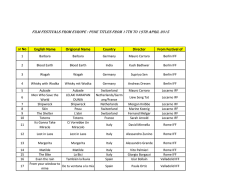
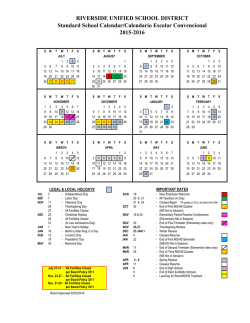

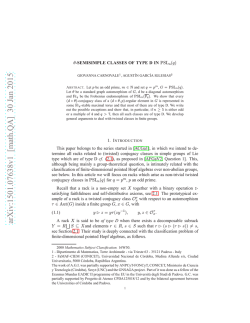
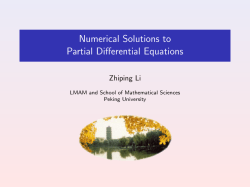
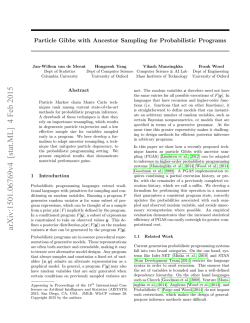
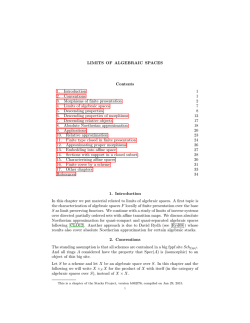
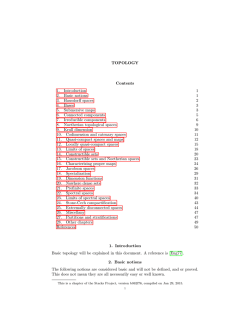
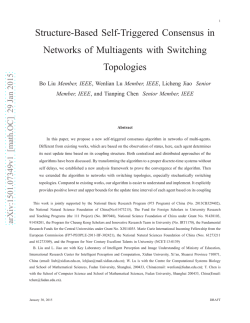
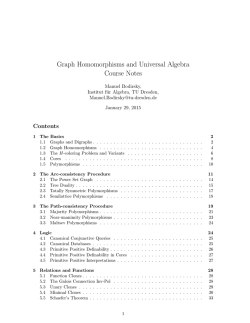
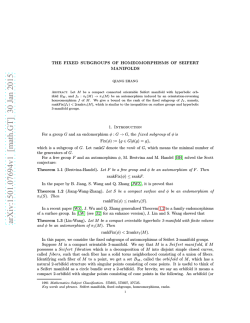
![arXiv:1501.07540v1 [math.AT] 29 Jan 2015](http://s2.esdocs.com/store/data/000489442_1-e95e1819e216359e95b991ff830a0678-250x500.png)
